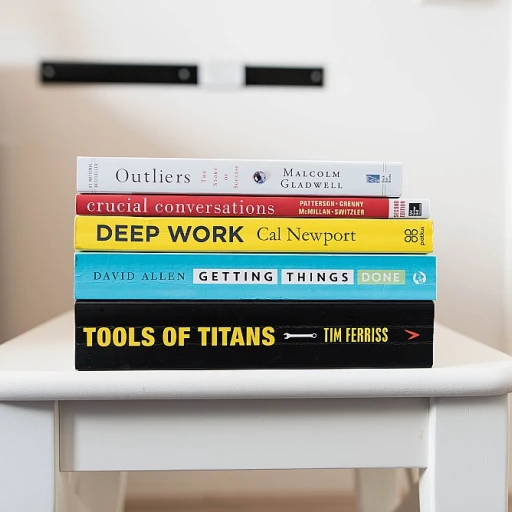
Understanding the Role of Personal Wikis in Continuous Learning
Decoding the Impact of Personal Wikis on Lifelong Learning
In the realm of continuous learning, personal wikis like TiddlyWiki have emerged as transformative tools. They serve as dynamic platforms that adapt to varied learning needs, facilitating a deeply personalized approach to information management. The intuitive design of TiddlyWiki allows users to create a network of interconnected notes, known as "tiddlers." This Wiki-based software, distinguished by its open source framework, provides users the flexibility to capture and organize data as simple text files. The free open and accessible software features robust capabilities that help in structuring content efficiently. A personal wiki helps manage the deluge of information one might encounter on a daily basis. It acts as a digital repository where you can seamlessly categorize and retrieve information with ease, akin to utilizing an integrated text search function. For instance, TiddlyWiki's filter and operator tools refine and display relevant data, based on your current learning objectives. One of the powerful applications of TiddlyWiki lies in its ability to enable hyperlinks, or "links," between tiddlers. This feature assists in building a cohesive web of knowledge, helping users to see the larger picture in their learning journeys. With the use of tags, lists, and a "table contents" view, organizing vast amounts of research notes becomes a manageable endeavor. In project management scenarios, TiddlyWiki facilitates effective collaboration. By sharing "message tiddlywiki" among team members, or utilizing community resources like TiddlyWiki GitHub and Groups Google, users can leverage collective wisdom to enhance their understanding and problem-solving skills. For those looking to implement TiddlyWiki effectively, understanding the platform deeply can be enlightening. Resources such as full text guides or exploring examples can solidify its practical uses. If you're interested in learning more about the time investment for mastering essential software tools, read our blog on how long does it really take. In conclusion, the integration of personal wikis into one's learning strategy can significantly enhance the way we absorb and utilize information. Whether you're delving into topics from months ago or organizing insights gained years ago, TiddlyWiki offers a robust foundation to support lifelong learning.Setting Up Your TiddlyWiki for Optimal Learning
Optimizing Your TiddlyWiki Setup for Effective Learning
Embarking on your personal wiki journey with TiddlyWiki can be both exciting and overwhelming, especially with the numerous customization options available. To make the most of this robust wiki software, it's crucial to set up your TiddlyWiki for optimal learning outcomes.Getting Started with TiddlyWiki
First, you'll need to download the TiddlyWiki software from the official site or through their GitHub repository, "TiddlyWiki GitHub." This free open source tool allows you to modify and personalize your wiki environment extensively.Organizing Your TiddlyWiki Environment
- Create a Clear Structure: Start by organizing your content with a clear and logical structure. Utilize the "table contents" feature to outline your learning paths and keep track of topics.
- Utilize Tiddlers: Use "tiddlers" to manage individual notes or topics. Think of each tiddler as a page where you can store related "notes," "text," and "links." Linking tiddlers effectively can enhance navigation and content "search" within your "personal wiki."
- Leverage Tags and Filters: Tags and "filter" options enable you to categorize and retrieve information easily. For example, use tags like "project management" or "plain text" for specific topics, so you can retrieve them quickly with a simple text search.
Customizing for Personalization
- Add Plugins and Extensions: Enhance the functionality of your TiddlyWiki by integrating plugins for additional features. Whether for automating tasks or adding visual elements, plugins help tailor your wiki to your needs.
- Visual Adjustments: Customize the look of your wiki to suit your preferences. Adjust colors, fonts, and layouts to improve readability and create an inviting learning environment.
Synchronizing with Other Tools
Maximize your learning potential by integrating your TiddlyWiki with other "learning tools." This might include syncing it with third-party apps or your calendar for reminders and workflow solutions.Enhancing Your Learning Experience
In summary, setting up your TiddlyWiki for "effective learning" involves organizing your notes, optimizing your environment with useful extensions, and integrating with other necessary learning tools. By customizing your setup to fit your learning style, you'll find that your personal wiki becomes an indispensable ally in your continuous learning journey. For those looking to delve deeper into strategies for mastering lifelong learning and emotional regulation, consider exploring the best books for mastering emotional regulation.Examples of TiddlyWiki in Action
Practical Illustrations of Utilizing TiddlyWiki
TiddlyWiki stands out in the realm of personal wikis due to its adaptability and versatility. A pivotal asset in continuous learning, it becomes indispensable when effectively applied to real-world scenarios. Here's a closer look at how TiddlyWiki can be leveraged for various use cases:- Project Management: TiddlyWiki is a powerful tool for organizing project tasks. By using tiddlers to track each phase of a project, you create a comprehensive table of contents that keeps everything orderly. Beyond plain text notes, the software allows you to include links and integrate with other learning tools, providing a cohesive project management solution.
- Knowledge Repositories and Research: Whether you're building a personal knowledge base or conducting deep-dive research, TiddlyWiki offers free open source capabilities for creating detailed, interconnected notes. You can employ filters and tags to refine your text search experience and easily locate information across months or even years of content.
- User Wikis and Community Engagement: As an open source platform, TiddlyWiki benefits from a robust community. By participating in groups on Google and exploring plugins on TiddlyWiki GitHub, users can expand their personal wikis and gain access to innovations seeded by other operators.
Integrating TiddlyWiki with Other Learning Tools
Enhancing Your Learning Toolkit with TiddlyWiki
Integrating TiddlyWiki with other learning tools can significantly enhance your continuous learning process. Here are some practical ways to make TiddlyWiki complement your existing educational toolkit:- Combining with Note-Taking Apps: TiddlyWiki can work alongside popular note-taking applications to provide a more dynamic platform for capturing insights. While traditional note apps focus on linear recording, TiddlyWiki allows you to create interlinked tiddlers, making it easier to see relationships between different topics.
- Project Management and Task Tracking: For those who use project management tools, TiddlyWiki can serve as a personal wiki to detail project backgrounds, goals, and progress. The flexibility of a personal wiki makes it ideal for adapting text-based project notes and linking them with visual management tools.
- Archiving and Search Capabilities: One of TiddlyWiki's strengths is its full-text search capability. It stores information in plain text format, allowing users to perform deep searches that other software might miss. This makes it a valuable complementary tool for content-rich projects.
- Collaborating with Software Development Tools: Developers often use wikis for documentation purposes. Integrate TiddlyWiki with your version control systems like GitHub to manage project documentation effectively. TiddlyWiki's open source nature and user-friendly text operator features make it an accessible addition to any developer's toolbox.
- Filtering Information: Use TiddlyWiki's filter capabilities to distill complex data into more manageable chunks. By applying filters, you can create custom lists based on specific topics or keywords, making your search for information more efficient.
- Linking Educational Resources: TiddlyWiki allows the creation of 'links' between related content. As you gather information from various sources, TiddlyWiki can act as a central hub, helping you connect disparate notes, projects, and educational materials efficiently.
Overcoming Common Challenges in Using TiddlyWiki
Addressing Common Roadblocks in TiddlyWiki Utilization
Embarking on the journey of using TiddlyWiki as part of your continuous learning strategy can be an exhilarating experience. However, as with any tool, there are challenges that may arise. Here are some common issues users face and potential solutions to help you maximize your personal wiki experience.
Navigating the Learning Curve
TiddlyWiki is a sophisticated open-source wiki software that's packed with features, which can be overwhelming for beginners. To mitigate this, start by focusing on the essentials. Gradually introduce advanced functionalities as you become more comfortable. Many users thrive by engaging with online communities, such as Groups on Google or TiddlyWiki GitHub, to ask questions and gain insights.
Organizing Tiddlers Effectively
The power of TiddlyWiki lies in its flexibility with tiddlers — the building blocks of your personal wiki. To prevent clutter, establish a consistent tagging system for quick text search and easy retrieval. Use links and group related tiddlers to create a structured Table of Contents that reflects your learning objectives.
Improving Search Efficiency
The ability to perform a full text search is crucial in a personal wiki. If searches are returning too many results, refine your query using filters and text operators. This will help you pinpoint the exact information you need without sifting through irrelevant data.
Tackling Data Management and Backup
Since TiddlyWiki stores data locally, it's essential to maintain regular backups to prevent loss of information. Consider using version control systems or cloud storage solutions to safeguard your notes and ongoing projects. This will not only ensure data integrity but also enable you to track changes over time.
Integrating with Other Tools
As explored earlier, connecting TiddlyWiki with other learning tools enhances its utility. Despite potential technical hurdles, integrations can be managed by using plugins or third-party software that facilitates communication between tools. Be proactive in experimenting and finding what works best for your specific context.
By proactively addressing these common challenges, you can transform your TiddlyWiki from a simple collection of text files into a dynamic user wiki tailored to your continuous learning goals. Remember that persistence and community support can make a significant difference in overcoming initial obstacles and unlocking the full potential of your personal wiki.
Maintaining and Evolving Your Personal Wiki
Ensuring Continued Growth of Your Personal TiddlyWiki
Regularly maintaining and evolving your TiddlyWiki is key to maximizing its benefits as a personal learning tool. Here are some strategies to keep your personal wiki dynamic and effective:- Routine Updates: Regularly update your TiddlyWiki content by adding new tiddlers or revising existing ones. This practice helps in refreshing the knowledge database and ensuring that your learning remains current.
- Spring Cleaning: Periodically, comb through your tiddlers to remove obsolete or irrelevant information. This prevents clutter, making your wiki a more efficient space for learning and retrieval.
- Organizational Enhancements: As your knowledge expands, reorganize your tiddlers to reflect the new structure. Utilize filters and links to create better connections between related notes and topics. Streamlining your table of contents can significantly enhance navigation.
- Experiment with Plugins: TiddlyWiki offers a range of plugins that can add functionality or improve the user interface. Exploring these additions can tailor the wiki software to better suit your personal learning style.
- Integrate New Insights: Bringing in perspectives from other learning tools or platforms can enrich your personal TiddlyWiki. Linking to other software and integrating insights from different sources, as discussed earlier, helps create a comprehensive learning hub.
- Community Engagement: Participate in groups, such as those on Google, dedicated to TiddlyWiki. Sharing experiences and learning from other users can inspire new ways to enhance your personal wiki.
- Backups and Version Control: Frequently back up your TiddlyWiki files or use platforms like TiddlyWiki GitHub to ensure that your data is safe. This practice also facilitates tracking changes and retrieving previous versions if needed.












